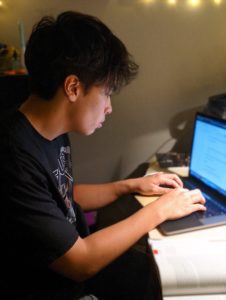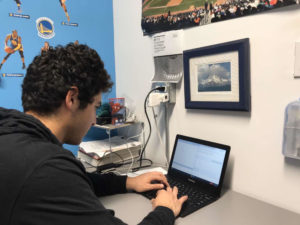
Benicia High School senior Jett Walker works on distance learning studies. Walker notes that learning online has actually decreased his understanding and comprehension of subjects.
By Emma Goularte, Special to the Herald
Every student has different home lives and it is unrealistic to believe that all students will have the same opportunities as others. Some people live in different places and some have limited access to what they need. It is inequitable to expect that everyone has the same circumstances.
“Learning online has decreased my actual understanding of many school topics,” said Benicia High School (BHS) senior Jett Walker. “In order to fully comprehend topics to their full extents, I need to really get involved in person. Online schooling does offer this to a certain extent, but it lacks the actual ability of becoming fully engaged in certain topics.”
BHS loaned out chromebooks at the beginning of the year to supply students with equal devices. These devices were meant to help students with homework and so teachers could use more materials online and all students have a device, but that option isn’t always available.
“Going 1-1 at BHS, has been a huge step in our district trying to close the digital divide, as well as our district connecting families before “distance learning” with discounted internet service and now after the pandemic, even more, discounted service,” said Leslie Beatson, Assistant Superintendent Benicia Unified School District, who recognized that lack of internet service is still an issue for many students.
Tony Thurmond, State Superintendent of Public Instruction, announced on April 16 the creation of a new task force, titled, Closing the Digital Divide Task Force, designed to help bridge the digital divide.
“This task force signals a new era, that Calif. is now working with focus and urgency to close the digital divide in the most concrete way we have ever seen,” said Thurmond. “COVID-19 is a public health crisis in Calif. and all around the world, but it’s also revealed other crises like the technology gap that has persisted for too long, leading to opportunity and achievement gaps for California’s students.”
The state’s task force was created to help students in Calif. who lack internet connection and electronic devices get the help they need during shelter-in-place.

Benicia High School senior Mason Donabedian works on his distance learning studies from home. Students report that some of the work is too difficult and some teachers have a hard time understanding the software.
“Bridging the digital divide is difficult but possible, in my opinion,” said BHS Principal Brianna Kleinschmidt. “Of course, it depends on how you look at this in terms of technology devices, access to needed resources such as WiFi, and then the ability to effectively use technology.”
California State Senator Connie Leyva (D-20), will serve as co-chair of the task force.
“I strongly believe that ensuring equality for California students is critically important,” she said.
The California Department of Education announced that it partnered with the Californians Dedicated to Education Foundation (CDE Foundation), the private non-profit partner of the CDE since 2011, to create the California Bridging the Digital Divide Fund. The fund is a joint effort of the Governor’s Office, State Board of Education, CDE, and CDE Foundation, and is a centralized resource for state leadership to provide essential device, connectivity, and related digital learning supports for pre-K-12 students, teachers, and their families.
The fund is focused particularly on building more equitable teaching and learning environments, which are currently in even greater jeopardy due to the uneven impacts of COVID-19 on students, families, and educators.
“I think at this time the digital divide that persists is in effective use of technology for learning,” said Kleinschmidt. “Our high school students have grown up with technology and are tech-savvy, but not always in ways that helps them with learning and with producing assignments. For example, students are likely much more skilled at quickly texting and messaging than older generations, but not as skilled with typing an essay with 50 to 60 words per minute. Use of software programs and apps greatly vary also. I think this is the area where we have grown the most in a short amount of time since moving to distance learning, but where we also see need for further growth.”
This includes special attention to special education, English learner, low-income, and rural populations, for which additional virtual educator professional learning webinars are now in development by the state.
“I think that there is a digital divide at BHS, especially with teachers who don’t understand how the programs we are using work,” said senior Kenzie Bradley. “It can be confusing and hard to understand the material at times. I also think that teachers are giving larger work loads because we have less projects and more busy work which adds up throughout the week. It makes it difficult to create new routines for ourselves and difficult to focus on learning important material.”
To support bridging the digital divide, Gov. Gavin Newsom joined in with his support.
“School may be physically closed, but class is still in session,” he said. “But for class to be in session, it is imperative that Calif. addresses the inequalities in access to computers, technology tools, and connectivity to ensure that online learning can in fact reach all of California’s children.”
In the effort to help mend the divide, leaders throughout the state are working to give internet access to hundreds of thousands of households. Along with internet access, they have also donated over 70,000 students chromebooks, tablets, and laptops.
“I do think it is possible to bridge the digital divide with technology becoming more affordable and accessible,” said K-2 SDC Rodeo Hills Elementary teacher Megan Tucker. “I hope we see more companies providing recourses for students and communities in the coming months. I have embraced online learning to the best of my ability and enjoy checking in with my students each morning, but miss the face-to-face contact with them. I would like to be able to engage more with each of my students through online learning. Accessibility and ability to use technology independently are major barriers for my students.”
About one in five students lack high-speed internet or devices available for them at home in the state. In order to bridge the divide and help families provide what is necessary for online school, companies, organizations, philanthropists, and business leaders are donating resources such as money and/ or devices. Some of the contributions are as follows:
- T-Mobile is donating 13,000 tablets and 100,000 hotspot devices.
- Amazon is donating 10,000 tablet devices.
- Chan-Zuckerberg Initiative, Jack Dorsey, and Ann & John Doerr are all donating $1,000,000.
- Apple has been offering free coaching lessons to help teachers transition into online teaching with 800 districts. They are also offering special prices for IPads with cellular, along with giving about 9,000 IPads.
- Verizon is working with California in giving about 250,000 students a discount with unlimited internet service.
- Devices for Students is a nonprofit organization which has helped over 550 students in over 30 schools gain access to the technology to help every student succeed.
These are contributions that have been made, but they aren’t the only ones. Many have wanted to help make this transition easier for students as well as teachers.
“Often, it’s the students who find ways to troubleshoot, and adjust to technology usage at a quicker rate than some adults,” said Joe Henderson Elementary 3rd grade teacher Jennifer Cairns. “I have noticed that with access to technology, students have been able to be creative in many ways, digitally, such as publishing original writing and art. I think that elementary students who have been impacted by our nation’s pandemic will now have a new level of knowledge and experience to move forward with integration of technology into their education, weather it is remote, or when we physically go back to school.”
This is uncharted territory and in order for this to work everyone needs to come together to ensure that children all have equal opportunities in education.
” Sure, you can bridge the digital divide in terms of giving every student access to a device and internet. What you cannot bridge is the divide created by kids having different degrees of structure and support provided in their different home settings,” said Rodeo Hills Elementary 4th grade teacher Alissa Barton. “You cannot bridge the fact that some parents are able to sit with and encourage their kids with their work while others are still working, either in or out of the home. Distance Learning requires a great deal of independence and self-reliance which poses a significant challenge for equity.”
In order to bridge the divide it takes an all hands on deck approach and many people are willing to help. If we all come together in this uncertain time we can make a difference and help people when they need it the most.
“If I could alter the online learning, I would aim to make teachers more accessible in providing lessons that are similar to physical class lessons so students have the option to keep things similar to what they were,” said Charter University Prep senior Leah Harris. “Allowing students different options for their online learning presents more opportunities for students to prosper because different students learn in different ways.”






Leave a Reply